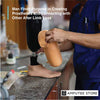Understanding Pain After Limb Loss
Pain after limb loss is different for everyone. What is low-level pain for one person may be high-level for someone else. Pain also comes with emotional aspects, which are difficult to define in a medical context.

The best way to let your healthcare team determine a pain management plan for you is to understand and describe what you feel. You’re the only one who can feel the pain and determine where it’s from. Only you can also communicate whether the pain management plan is working.
Typically, your healthcare team will ask you to rate the intensity of the pain, with 0 as no pain and 10 being the worst pain imaginable. This information will help your doctor prescribe the correct pain medication in the appropriate amount.
Furthermore, pain is described as either chronic or acute. The former lasts longer and may be a permanent condition, while the latter is temporary.
Below will help you describe your pain.
Describing your pain
Descriptive words are helpful for your healthcare team. You can use words like a dull ache, pins and needles, pinching, sharp, shooting, stabbing, throbbing, tingling, and twisting.
Your ability to communicate your pain to your physician is essential. If the issue is not treated early, pain can become more intense and hinder the healing process.
Before starting a pain management program, it’s also a good idea to discuss your history with specific medication or medication addiction.
Pain management
Pain management requires a comprehensive approach. Your physician, prosthetist, therapists, and mental health consultants should work with you to determine the cause of your pain and then formulate a focused treatment plan.
You may be prescribed traditional pain medications, like anti-inflammatory agents and muscle relaxants, to relieve pain from a physical injury. However, these medications don’t work for nerve pain.
If you have nerve pain, you may be treated with anti-depressants or anti-seizure medications. These medications change the nerve’s chemistry, stopping the pain or blocking pain signals to the brain. Some people who have nerve pain after limb loss opt to keep taking pain medications for the rest of their lives.
Always remember to report any discomfort or pain to your healthcare team as soon as you notice it so they can help you address the issue before it gets worse.
Other ways to deal with pain
Medication is not the only way to manage pain. Below are some techniques you can try to help manage your pain.
Keep a pain journal
It’s essential to keep track of your symptoms and triggers. Writing everything in one place makes it easier for your healthcare team to recalibrate your pain management plan.
Wear your prosthetic limb
For some people, wearing their prosthetic limb alleviates pain. They only start feeling painful sensations when they remove their prostheses.
Wear shrinkers
Wearing a shrinker, especially during the first few months after your surgery and at night, may help alleviate pain. This is because compression helps reduce swelling and relieves pain and other abnormal sensations. You might want to continue wearing your shrinker at night once you receive your prosthesis.
Desensitization techniques
Desensitization techniques include brushing, massaging, tapping, and wrapping your residual limb. These can help relieve pain. Ask your physical therapist to demonstrate these techniques to you.
Be mindful of your triggers
Phantom limb pain can be triggered by various conditions or activities, like weather changes and touch. Write these in your pain journal. And while some triggers are avoidable, others cannot. Your healthcare team will help you manage any unavoidable pain triggers.
Exercise
As soon as your surgeon allows you to exercise, do so. Besides improving your overall health, exercise interrupts pain signals. So, go ahead and stand, stretch, or walk. It’s good for you.
Relaxation techniques
Pain increases with stress and tension. This is why finding the proper relaxation technique is essential. You might want to try some tried and tested techniques first, like meditation, yoga, breathwork, journaling, and mindful walking.
Join a pain support group
Sharing your experiences and getting the support of people who understand pain is beneficial for your recovery and overall quality of life. Even if your friends and family are supportive, joining a pain support group may help you find ways to cope with your pain better.
The bottom line
Pain decreases your quality of life. It can make it impossible for you to sleep and function when you’re awake. Living with chronic pain can be frustrating and overwhelming, and if not addressed, can lead to depression. Although understanding pain won’t make it go away, it can make it easier to tolerate and manage.










































































